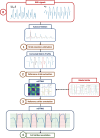Automatic gait events detection with inertial measurement units: healthy subjects and moderate to severe impaired patients
- PMID: 38890696
- PMCID: PMC11184826
- DOI: 10.1186/s12984-024-01405-x
Automatic gait events detection with inertial measurement units: healthy subjects and moderate to severe impaired patients
Abstract
Background: Recently, the use of inertial measurement units (IMUs) in quantitative gait analysis has been widely developed in clinical practice. Numerous methods have been developed for the automatic detection of gait events (GEs). While many of them have achieved high levels of efficiency in healthy subjects, detecting GEs in highly degraded gait from moderate to severely impaired patients remains a challenge. In this paper, we aim to present a method for improving GE detection from IMU recordings in such cases.
Methods: We recorded 10-meter gait IMU signals from 13 healthy subjects, 29 patients with multiple sclerosis, and 21 patients with post-stroke equino varus foot. An instrumented mat was used as the gold standard. Our method detects GEs from filtered acceleration free from gravity and gyration signals. Firstly, we use autocorrelation and pattern detection techniques to identify a reference stride pattern. Next, we apply multiparametric Dynamic Time Warping to annotate this pattern from a model stride, in order to detect all GEs in the signal.
Results: We analyzed 16,819 GEs recorded from healthy subjects and achieved an F1-score of 100%, with a median absolute error of 8 ms (IQR [3-13] ms). In multiple sclerosis and equino varus foot cohorts, we analyzed 6067 and 8951 GEs, respectively, with F1-scores of 99.4% and 96.3%, and median absolute errors of 18 ms (IQR [8-39] ms) and 26 ms (IQR [12-50] ms).
Conclusions: Our results are consistent with the state of the art for healthy subjects and demonstrate a good accuracy in GEs detection for pathological patients. Therefore, our proposed method provides an efficient way to detect GEs from IMU signals, even in degraded gaits. However, it should be evaluated in each cohort before being used to ensure its reliability.
Keywords: Dynamic time warping; Gait analysis; Intertial measurement units; Pathological gaits; Pattern recognition; Step detection.
© 2024. The Author(s).
Conflict of interest statement
The authors declare that they have no competing interest.
Figures












References
MeSH terms
LinkOut - more resources
Full Text Sources
Medical

